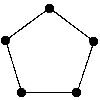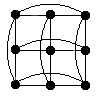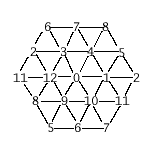

The graphs that bear his name are constructed as follows: Given a finite field F with q elements, make a graph with vertex set F where two vertices are joined when their difference is a square in the field. This is an undirected graph when q is congruent 1 (mod 4).
For q = 4t + 1, the parameters are v = 4t + 1, k = 2t, λ = t − 1, μ = t.
Examples (q = 5 and q = 9):


For q = 13 the Paley graph is locally a hexagon, so that the graph is a quotient of the hexagonal grid:

(More generally, the graph on the elements of GF(q), where q=6t+1, where x and y are adjacent when (y−x)6 = 1, is locally a hexagon, unless q is a power of 7.)
Paley graphs are isomorphic to their complements: if a is a nonsquare, then the map that sends x to ax is an isomorphism from the graph to its complement.
The subgraph induced on the neighbors of 0 (that is, on the set of squares) has full group generated by the maps x ↦ ax where a is a nonzero square, the field automorphisms, and the map x ↦ x−1 (Muzychuk & Kovácz, 2005). If q > 9 it has order e(q−1).
A small table with independence numbers and chromatic numbers:
| q | 5 | 9 | 13 | 17 | 25 | 29 | 37 | 41 | 49 | 53 | 61 | 73 | 81 | 89 | 97 | 101 | 109 | 113 | 121 | 125 | 137 | 149 | 157 | 169 | 173 | 181 | 193 | 197 | |
| α | 2 | 3 | 3 | 3 | 5 | 4 | 4 | 5 | 7 | 5 | 5 | 5 | 9 | 5 | 6 | 5 | 6 | 7 | 11 | 7 | 7 | 7 | 7 | 13 | 8 | 7 | 7 | 8 | |
| χ | 3 | 3 | 5 | 6 | 5 | 8 | 10 | 9 | 7 | 11 | 13 | 15 | 9 | 18 | 17 | 21 | 19 | 17 | 11 | 18 | 20 | 22 | 23 | 13 | 22 | 26 | 28 | 25 |
The chromatic numbers for q=125,173,197 are due to Geoffrey Exoo (pers. comm.).
Since the Paley graphs are self-complementary, their clique numbers equal their independence numbers. By the Hoffman bound, the independence number is at most sqrt(q). For prime q, Hanson and Petridis improved this upper bound to roughly sqrt(q/2), more precisely (1+sqrt(2q−1))/2. Equality holds for q=5, 13, 41.
A much stronger result is found in A. Blokhuis, On subsets of GF(q2) with square differences, Indag. Math. 46 (1984) 369-372. This paper shows that if a subset of GF(q) has size sqrt(q) and all differences are squares, or all differences are nonsquares, then the subset is the affine image of a subfield. In particular, this determines all cliques and all cocliques of size sqrt(q) in the Paley graph of order q.
For q = r2 with r = 4t±1, smaller maximal cliques (of size 2t+1) are constructed in R. D. Baker, G. L. Ebert, J. Hemmeter, A. J. Woldar, Maximal cliques in the Paley graph of square order, J. Statist. Plann. Inference 56 (1996) 33-38. They conjecture that no maximal clique in the Paley graph of order r2 has size strictly between 2t+1 and r.
See also M. Kiermaier & S. Kurz, Maximal integral point sets in affine planes over finite fields, Discr. Math. 309 (2009) 4564-4575, and S. Goryainov, V. V. Kabanov, L. Shalaginov & A. Valyuzhenich, On eigenfunctions and maximal cliques of Paley graphs of square order, Finite Fields Appl. 52 (2018) 361–369, and S. Goryainov, A. Masley & L. Shalaginov, On a correspondence between maximal cliques in Paley graphs of square order, Discr. Math. 345 (2022) 112853.
| size | q |
|---|---|
| 2 | 5 |
| 3 | 9-25 |
| 4 | 29-81 |
| 5 | 89-373, 401-409, 433, 457, 569, 953 |
| 6 | 389-397, 421, 449, 461-557, 577-941, 961-1213, 1229, 1249-1289, 1321, 1369, 1409, 1553, 1669 |
| 7 | 1217, 1237, 1297-1301, 1361, 1373-1381, 1429-1549, 1597-1657, 1681-2029 |
Similarly, for Paley tournaments P(q) one has:
| size | q |
|---|---|
| 2 | 3 |
| 3 | 7-11 |
| 4 | 19-59, 103 |
| 5 | 67-83, 107-311, 343, 379 |
| 6 | 331, 347-367, 383-1151, 1171, 1223, 1331, 1723 |
| 7 | 1163, 1187, 1231-1327, 1367-1699, 1747-2039 |
See Changwoo Lee, The domination number of a tournament, Kangweon-Kyungki Math. J. 9 (2001) 21-28.